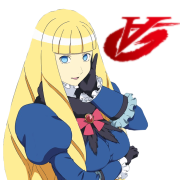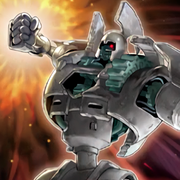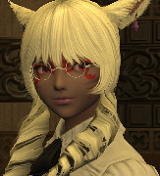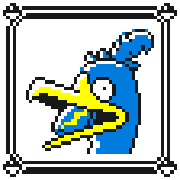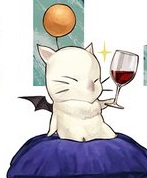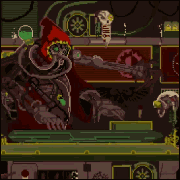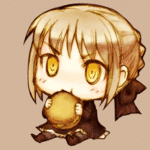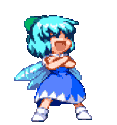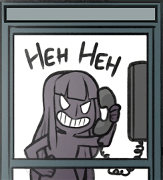|
If I changed my hair to match, I'd probably make a passable Replacement Moenbryda, and nobody wants that.
|
|
|
|

|
| # ? Jun 11, 2024 22:00 |
|
Craptacular! posted:For all my criticism of Stormblood, I think it has some of the best Job Quest arcs.
|
|
|
|
I do like these warriors a bit more, that intro is very funny.
|
|
|
|
Yeah it owns lol
|
|
|
|
Lord_Magmar posted:Ehhhhhh, whilst it's true that Samurai has a defensive. Of the defensive buttons that exist on melee it's the weakest, for it to do as much as the closest equivalent (on a job not yet seen), the boss needs to hit you for more than your entire health bar. Samurai also completely lacks additional self healing, which is something almost every other melee does have. In fact, I think every Melee except dragoon has their own defensive, and dragoon instead gets a potent self heal button. Third Eye is pretty good in raids, you can third eye pretty much every raid-wide and targeted hit and 10% mitigation is pretty decent when some of them will do more than 100% of your HP in damage unmitigated.
|
|
|
|
Lazy Fair posted:Third Eye is pretty good in raids, you can third eye pretty much every raid-wide and targeted hit and 10% mitigation is pretty decent when some of them will do more than 100% of your HP in damage unmitigated. Oh I'm well aware, I am still a SAM main. Just offering my thoughts on why Sam feels squishy at times compared to when I play another melee. It's also worth noting that compared to other defensives, Third Eye only works on one hit (Ninja gets a 20% health shield for an example that we've actually seen so far), so it can have tight timing, and does nothing for damage over time effects for example. It's a good ability, but it isn't what I'd call a "strong" defensive. You get it every raid-wide because it's only a 10% reduction on a single hit and it's intended as a mechanical skill/knowledge check because every correctly used third eye is a dps increase, on a job whose sole purpose is doing dps from a group standpoint.
|
|
|
|
Yeah, I'd call RPR, NIN, BLM and especially SMN's defensives "strong." Third Eye, however, is consistent - you'll likely be able to use it on every source of damage you take in a given fight, though it's not nearly as useful for mitigating big hits like other defensives.
|
|
|
|
Chapter 20: Swordsoul III – Rules of Nature From the moment we arrive in Gridania, Momozigo is nervous. Not the average nervousness any rational person would have in the city where picking up the wrong seed might get you thrown in prison, but anxiety that speaks to a more specific history with the place. Regardless, he still trundles off to chat with his contacts and find us an evil to smite. Except this time, he doesn’t come back. Musosai and Kheris ask around town and discover that the Twin Adders arrested him. The Warrior of Light seeks out her old ally Serpent Commander Heuloix to get an explanation, expecting something idiotic and Elemental related, but against all odds, their actions might have some merit.  Embezzlement? I didn’t see that coming. Based on Vorsaile’s tone, the theft was relatively petty, but Gridanians aren’t known for letting go of slights. Unfortunately, things have become significantly worse than trial and punishment for a minor infraction. Momozigo chose to flee custody while his guard’s backs were turned, and his escape route blundered straight into Ixal territory. Attempting to apprehend him now means a military deployment and risking soldiers’ lives, and since we’re at war right now, the Serpents’ brass is likely to leave Momo to his fate. What was that little dummy thinking? We rush through the Shroud and are fortunate enough to find our friend moments before a gang of bird boys would have had their way with him. Kheris takes them out, and Momo tearfully mocks himself for being a hypocrite, a criminal playing at fighting crime with the noble samurai. He then confesses the full scale of his misdeeds in all their horror:   That’s right; he stole the advanced ticket proceeds of a single concert. We’ve got a regular Lolorito on our hands here. I guess the answer to what was running through his head when he ditched the cops was “nothing.” Momo asks Musosai if he will be punished like all the others, and Musosai gives Kheris a little wink before making a speech about how breaching the public trust was an egregious misdeed. The camera fades to black, and we hear the snicker-snack of the katana… but, as if there was any doubt, Momo is untouched.  (This might be much more important than it seems. File this away; we’ll talk about it again soon) Still playing his part, Musosai makes Momo swear never to break the law again and to continue his service in our mission to hunt down evil. He then gently suggests that our little pal use the money he made promoting those katana duels in the arena to pay back the money he stole and apologize. Momo rushes off to do just that. Once he’s out of earshot, my teacher can’t help but have a chuckle at his expense.  …  The old man doesn’t even try to play off this second collapse as no big deal, cursing his body for giving in to the ravages of old age. He decides it’s time for a confession of his own: while he came to Eorzea to find an apprentice, that wasn’t his only objective. He also came in pursuit of a disgraced samurai, Kogarashi. This swordsman, he claims, is pure evil. He opines that he had the chance to slay him once before and failed. With his health, the next attempt might be his last. But that’s a story that will have to wait. The wind calls us to travel again, and we’re off to the mountains this time. “What evil could we possibly find in Ishgard,” I ask, with sarcasm so thick even FOLDED STEEL couldn’t cut it. ~*~*~ Gridania’s samurai tale was a short one, which allows me to talk about a topic many people in the comments saw coming: the meanings behind the Job’s ability names. Initially, I hadn’t planned to do a deep dive on this for a simple reason: no kanji. Japanese has many homophones, and while a native speaker can generally tell from context which ‘version’ of a word is being used, I am not a native speaker. A lot of Samurai ability names have multiple possible translations. Since the original text of the game leans on the hiragana and katakana lettering systems, it’s significantly harder to decode certain meanings. I would have to go to the Chinese version of the game and then translate those names back into Kanji before translating them into English, which is a lot. But then my research sent me a savior. Reddit user aoikageni and FF14 Player/Blogger Rainy Moon did a lot of the work for me years ago! I had to double-check the work and dig to understand and clarify some things, but generally, this whole section will be heavily cribbed from their efforts. Wherever you are, bravo to you both. The best place to start talking about Samurai Buttons is the concept of Setsugekka. This word translates to “Snow, Moon, Flowers,” but its cultural meaning is far more profound. The image first appeared in the work of a Tang Dynasty Chinese poet, Bai Juyi. It was used to describe the time of the year when the speaker thought of his beloved most often. Snow symbolizes the winter, Moon the autumn, and Flower the spring. In other words, the speaker loves the woman so much that he ALWAYS thinks about her (Summer doesn’t count for whatever reason). Bai Juyi was a great poet in China, but he was almost worshipped in Japan. The Tang Dynasty was the peak of Sino-Japanese cultural exchange in pre-modern times, and this guy was so highly rated in the Imperial Court that Murasaki Shikibu, who would be remembered as one of historic Japan’s greatest authors and poets, filled her writings with references to his work. It’s not surprising that something he invented became a bedrock of Japanese art across history. You see Setsugekka referenced in everything from ukiyo-e woodblock paintings of the Edo era to the Japanese title for Fire Emblem: Three Houses.  …  Just as “The Crown,” acts as conceptual shorthand for any given nation’s monarchy or “The Kremlin,” for the Russian government, Setsugekka is a metonym. It describes the natural beauty of Japan and the notion that it is eternal. These three pieces of nature, while dissimilar in almost every way, are united by their status as symbols of their time of year and their inherent beauty and elegance. Japanese society decided there was a need for a word to describe their local nature specifically because their zeitgeist reckons Japan’s land and climate are uniquely beautiful and diverse. Musosai, amusingly, will reference this mentality when we get to Ishgard, noting that each of Eorzea’s regions embodies a type of seasonal beauty despite barely changing throughout the year, making them collectively as colorful as Hingashi. This concept is the root of the symbolism and meaning behind the rest of the class. The three parts of the Sen Gauge are marked by the kanji Setsu, Getsu, and Ka: Snow, Moon, and Flower. The combo string finishers that activate the Sen Gauge each line up with one of these three. Gekko and Mangetsu are “Moonlight,” and “Full Moon,” respectively, and their animations flash a phantasmal image of the moon when you strike. Oka is a rare alternate word for Sakura, aka the Cherry Blossom (one which you may have heard because it was used as the name for one of the Late-WW2 Era’s purpose-built kamikaze planes). Kasha, literally “Wheel Flower,” seems to refer to a species of Japanese Azealia.  Like the moon attacks, these two moves come with very petal-y animations. Yukikaze translates to “Snow Wind,” and is meant to invoke something relatively gentle compared to a blizzard. Talking about the Sen activating attacks then leads us to the Iajutsu. One Sen will unlock Hinganbana, the poisonous Red Spider Lily. Perfect for a move that deals damage over time and has an animation featuring a dozen prongs. Three Sen unlocks Midare Setsugekka. We already know the second word, and if you look at the animation, you’ll see all three elements: the frozen ground, the glow of the moon, and the scattering petals. Midare means “Disturbed,” or “Disordered,” so the implication is that your strike is momentarily shattering the harmony of nature. This is ironic when you consider the main offensive cooldown, Meikyo Shisui, which allows you to hit your Sen Activators without comboing into them first. The term is an idiom that roughly translates to “A lake which is so still it is like a polished mirror.” This image symbolizes a mind that has achieved perfect serenity and clarity. It can perceive all and therefore accomplish anything. Many Japanese Martial Arts sub-cultures, especially those rooted in samurai history, consider this concept (though not necessarily this specific idiom) to be the pinnacle of their disciplines. When I lived in Japan and visited my high school’s archery dojo, the teacher explained that if a shooter can obtain this state, hitting the target is a foregone conclusion because you can understand that the arrow is already one with the target. Your movements only deliver it from Point A to Point B. To help reach this level, each of the eight distinct steps of the archery shot is meticulously practiced as a form of meditative ritual. For a more visual example, we can take a moment and watch the iconic “No Mind,” scene from Tom Cruise’s kind-of-problematic-but-still-enjoyable Dances-With-Wolves-alike The Last Samurai: https://www.youtube.com/watch?v=55Pi0F5PPNw Not every part of the Samurai class is linked to our three nature items. The combo starters Fuga and Hakaze, and the two combo extenders Jinpu and Shifu, are all Wind-related. Each of them (we would presume based on the pronunciations) uses 風, the kanji for wind. Amusingly though, only Hakaze (Blade Wind) reads that kanji in a way that means “wind.” The others were seemingly chosen because they used alternate readings of the symbol, thereby indulging the great Japanese tradition of pointless and convoluted puns. Fuga, for example, literally translates to “Elegance,” and is used to evoke Japanese artistic traditions focused on simplicity and restraint. Think of the traditional tea ceremony. Jinpu can be a gale-force wind, but it can also be a strategically important point on a battlefield that must be controlled to achieve victory. This double meaning makes it the perfect bridge between Hakaze and Shifu, roughly “the mindset and actions of a samurai/soldier.” Names aside, all of these attacks’ animations feature wind imagery. It’s not unusual to link sword techniques with the wind in Japan. Anyone who’s seen an anime has likely seen at least one character swing their katana so hard it creates razor-sharp air pressure. What you might not know is that this is an ancient concept. It dates back to a monster from folklore, the Kamaitachi. This weasel either carries a sickle or has blade-sharp claws and is so fast that you’ll never see it when it passes you. The only evidence of their existence is the high-speed winds they leave in their wake, and their favorite pastime is using those claws to slice open the exposed skin of helpless travelers. This story was intended to explain a real-life medical phenomenon where people traveling along windy mountain roads would discover inexplicable shallow cuts in their skin. As it turns out, this was the skin splitting from the cold, but over time this connection between speed, sharpness, and wind mutated into the idea that a sword moving fast enough could create a blast of wind with the same cutting power as the steel. Next, we have the Kenki attacks. Each of these is labeled with Hissatsu, a word used in pop media to signify an ultimate move. It translates roughly to “certain kill.” Shinten, Gyoten, and Yaten each used the Kanji ‘Ten,’ which I previously mentioned means ‘Sky’ or ‘Heaven.’ Shinten, the big damage strike, literally means “Quake the Heavens,” which is metal as hell. Gyoten, the charge strike, means “Dawn Sky,” while Yaten, the backstep, means “Night Sky.” The latter is further implied to be a sky lit only by the stars. It’s not entirely dark (hopeless), but there is no moon. Get it? And since Yaten powers up your ranged attack, Enpi, I can now mention its name means “a swallow in flight.” I already explained that significance when I discussed Hien’s name, so there you go. Finally, we should shout out the Two-Sen Iajutsu, Tenka Goken. It means “The Five Swords Under Heaven.” This is a real-life title granted to the five most precious katanas in Japanese history, held by the government and/or imperial household as cultural treasures. Note that I specified katanas. The legendary blades we’ve discussed previously, like Kusanagi and Ame-no-Habakiri, actually are not traditionally depicted as katana because their origins pre-date that design. What can we take away from all of this lore? The biggest thing is probably that every single part of the samurai’s kit is portrayed through the lens of metaphor, allusion, and art. There’s a deliberate effort to create an image that the job is something higher and nobler than a mere swordsman or soldier whose job is to kill. This effort makes sense in the context of the Job’s place in its fictional society, where they are accepted as protectors of the realm regardless of whether they operate within or outside the law. We’ve also already seen plenty of samurai who don’t fit this ideal. But hey, they’re not the first Job with a disconnect between the ideal and the reality. ~*~*~ Before she traipses off to Ishgard, there’s another old man Kheris wants to visit. She doubts she will take on Zenos with a bow and arrow, but with her conflicted feelings about the proper way to conduct herself as Warrior of Light and her struggle to help guide Lyse, a bit of time with Jehantel might be just what the doctor ordered. She connected with him, and he helped her to gain a deeper understanding of her shortcomings. Perhaps a few new songs will help her figure things out. Sadly, there’s no time to laze around the campfire. Since our battle on the Sea of Clouds, Sanson has received permission to establish his Bard Unit within the Twin Adders, and he has a favor to ask the Warrior of Light. While new Bards are being trained to fill out the ranks, the fact remains that, at present, they’re not ready for field deployment. That means the only person he can rely upon in actual combat is Guydelot. Sanson needs more troops to ensure his first deployment is a success. Considering those two will probably just make out all day if she’s not there to keep them on task, Kheris is willing to do them the favor. This first mission involves an anonymous letter delivered to the Adder’s Nest under cover of darkness. It’s an offer to hand over a book containing “damning secrets pertaining to the Autumn War.” Sanson immediately assumes command is giving him the run-around. What secret about a hundred-year-old conflict could anybody living today possibly care about? Unless it’s an embarrassing photo of a very young E-Sumi-Yan at the Seedseer Starlight Celebration party? Well, as we’ve established many times by now, Gridanians are douchebags and hold grudges forever. The fact that the Autumn War was 100 years ago might not matter to most of them. Not when they’re currently fighting a war to save those drat dirty Ala Mhigans.   …  Hey, there’s our boy! Guy has an excellent point: they’re assuming this is a secret that will make Ala Mhigo look bad and justify the smallfolk’s outrage at helping them, which could cause the Adders a lot of political problems within the Alliance. But what happens if it’s a secret that embarrasses Gridania? Of course, in Kheris’ experience, many Gridanians have no shame, what with leaving refugees to die and hunting down children for poaching to buy their big brothers’ medicine. But sarcasm aside, each city-state has made a habit of burying inconvenient history. Why should we contribute to the latest cover-up? Commander Heuloix can only promise that he won’t let that happen, assuming this isn’t a wild goose chase. Vorsaile is on Kheris’ short list of “People in the Shroud She’s Cool With,” so that’s good enough for her. Woe be on him if he disappoints her. Jehantel takes the opportunity to remark that this mission could prove far more critical than we expect. The emotional scars of the Autumn War run deep in the Black Shroud, and the Bards have a particularly close tie to those events because the Singing Archers fought in those battles. Like… the ones from that borderline mythological story you told me about Bard’s origins? Is the game implying that Bard as a Job is less than 100 years old? Surely not, right? The Moogles practice this art, and their civilization is ancient. Maybe it’s meant to be a ‘History Repeats Itself’ thing, like Singing Archers tend to appear across multiple eras and nations, and their development creates the potential for Bards to arise. It’d be similar to how we just learned Warrior powers independently developed on the far side of the world. Either way, it struck me as a weird tidbit to throw in for not much reason. Our team rolls out to Baelsar’s Wall, where we meet up with the fellow who sent the letter, a young Elezen named Nourval. He explains that he doesn’t have the tome he wrote about, only a story of its existence passed down through his family line since the Autumn War. He’d always dreamed of tracking the heirloom down, but it was left on the Ala Mhigan side of the border. Now that the Alliance controls the passage, he finally has his chance.  Sanson points out that this is basically extortion. The kid knows this book could be volatile depending on what secrets it’s hiding, and he’s using that to force us to let him ride along into a war zone. Guy agrees with this assessment… and that’s why he likes our new friend and votes to bring him along.  Jealousy is an ugly thing, Sanson. We arrive as Castrum Oriens with our tag-along. Before I continue the story, however, I want to point out something that struck me upon revisiting Gyr Abania: everything was the same. Every line of dialogue was precisely as I left it before sailing to Othard. I even teleported to Rhalgr’s Reach and saw that it had been frozen in time like nothing had happened since Zenos’ attack. That was four levels ago. I know it’s a silly thing to gripe about. After all, I’m theoretically across the world with no easy way to return. There’s no reason for them to update anything on the off-chance the player wants to teleport back before the story brings them home. And yet, it does bother me because FF14 has consistently set a high bar for small details like that. The critical locations like the Stones, Sands, and the cities updating themselves with small dialogue changes to reflect the passage of time is the norm, so it’s disappointing to see an exception made, especially since it was made explicit that they’re supposed to be rebuilding while I’m away. Anyway, once we’re at the base, Guydelot is in his element. He’s eager to start drinking and singing with the soldiers of the four nations so he can add to his collection of stories, but Sanson wants to get on with our search. However, Nourval suggests that rather than blundering into a countryside he only knows through childhood stories, we requisition a couple of billets here at the base and make plans before striking out. It seems like a reasonable suggestion, but it’s one that Sanson rapidly begins to regret approving. Nourval makes a massive pest of himself, bothering every soldier he sees with questions about everything he can think of, ostensibly to get the information he needs to find his lost book. Guydelot is predictably unhelpful, as he’s carousing with as many bottles as he can get his hands on. Sanson knows this is just how his partner operates, but it does leave him to try and handle the civilian tag-along by himself, which isn’t fun. While our Captain herds his kitten, Kheris asks Guy if his boozing led to anything useful. He’s cagey about it, claiming there are still pieces of the story he’s missing and that he needs more time to unearth them, but he did manage to find out that patrols out of the Castrum have been suffering ambushes recently, and they’re getting worse every night. The attackers are not Garleans but mysterious masked bandits. With his tip, Kheris manages to catch a squad of them in the act:  The scout she rescues informs Kheris that these bandits are finding Alliance teams even though they’ve been rotating their patrol routes and schedules. The only explanation is a leak from inside the base. She also notes something odd about their behavior: they seem more interested in keeping the Alliance out of a particular part of the wasteland than in killing or looting. Kheris brings this info back to the team, where Nourval complains about how Guy has been watching him. He’d mentioned that something about the civvie was bothering him, and frankly, I’d felt the same way. I mean, look at his face!  It’s like he’s going to invent used cars just so he can sell them to me. Sanson decides to lean on our new friend, arguing that we’ve learned enough about the area by speaking to the soldiers and that he should be able to start directing us to a target by now. Under this pressure, Nourval shares that the book should be hidden in a place connected to a man named Gylbarde. The name surprises my Gridanian pals because he was the General in command of the Ala Mhigan campaign during the Autumn War. This info prompts Guy to pick out a critical detail from Kheris’ report: the patrol the bandits intercepted was to pass near an ancient temple to Rhalgr known as Schism. Gylbarde was part of the Fist of Rhalgr, the monks who built such temples across Gyr Abania. The only logical conclusion is that these jerks are also after the book. Nourval uses this news as an excuse to continue pestering guards for intel. Sanson tries to stop him, but Guy tells him to shut up and listen. The thing he’s been piecing together over his cups is that our civilian has been sneaking out of the Castrum after dark when he thinks nobody is looking. The implications are obvious.  It’s ironic. Nourval had claimed he needed to speak to so many soldiers because hearing how they answered his questions could give him even more information than the actual answers. It never occurred to him that we might have somebody as capable of reading those clues as him. Sanson orders us to monitor Nourval’s activities to try and definitively determine what he’s plotting. Over several days, he prods the young man to start leading us out on searches of the local ruins, but he has an excuse that keeps Bard Squad in the base each time. At the same time, his nightly excursions grew longer, and bandit attacks increased. It’s pretty damning, if circumstantial, evidence. Sadly, Guy’s attempts to track him when he goes out at night have been continually foiled, so we have no smoking gun. The team decides there’s no choice but to entrap him. For several nights they come up with reasons to keep Nourval in their presence without a moment to himself, attempting to make him desperate to contact the bandits. With any luck, he’ll be sloppier than usual when we create an opening for him, and then we’ll be able to follow him.    All goes to plan. Nourval rushes out of the base almost the moment I inform him that the rest of the team is indisposed. We pursue him across the desert and catch him meeting with the bandits, and the first thing they do is address him as “my lord.” Figures. We picked the right day to spring our trap because the bandits announce that they’ve finally found the book. Nourval scoffs at what a bunch of idiots we are for not seeing that he was betraying us, as you do. More importantly, he proclaims that with this evidence, he’ll be able to turn every person in Gridania against Ala Mhigo. It all has to do with someone named Vainchelon. My compatriots explain that Vainchelon is Gridania’s greatest hero, who led their armies in the Autumn War. He is credited with stopping the enemy’s advance into the Shroud almost single-handedly until his death from an illness. After that, the only thing that saved their nation was the intervention of the rest of Eorzea and the formation of the original Alliance. Whatever secret the book contains, we all agree it can’t be used to turn Gridania against the Ala Mhigans, so we move to take it by force. The Duty battle is a fun one. It’s set up as an ambush, with Nourval’s archers hidden behind bits of ruined buildings while we fight him in an open plaza.  Nourval himself also displays some unique spear techniques which catch Sanson off-guard. Fortunately, he’s still young and inexperienced, so they’re not enough to stop us from seizing the book. Though frustrated by his defeat, Nourval dares us to read the thing as he retreats. He seems confident that once we see what was done to “his own blood,” we can’t possibly still feel sympathy for the Ala Mhigan dogs. As advertised, the journal was written by none other than General Gylbarde. It describes how he invited Vainchelon to a secret parley to offer peace terms behind the backs of his lower commanders and the king. This confuses Guydelot, who has never heard of such a meeting between the two legendary leaders. As it turns out, there’s a reason he never heard about it:  …  Vainchelon is basically worshiped by the common folk of Gridania and the rank-and-file of the military, held up as the ideal of everything their nation stands for. If word gets out that the illness that killed him was a lie meant to cover up that he was assassinated at a fake peace conference, there could be riots across the Shroud. The Adders continued participation in the war to liberate Ala Mhigo may become untenable, or worse, the Gridanian government might use this information as leverage against Ala Mhigo after the liberation to coerce concessions from an “ally,” that is entirely at their mercy. To call this a disaster in the making is underselling it. In the worst-case scenario, this could tear the Alliance apart and lead to a second Autumn War, or tank the liberation effort altogether and ensure Garlean hegemony over the region, which will inevitably lead to a full-scale counter-attack against Eorzea. None of this is lost on my team. They both find the idea of this hundred-year-old secret being used to justify hatred or violence against modern Ala Mhigans deplorable, especially when we're fighting for their freedom. And yet, they are both students of history through the Bardic arts. They have uncovered a profound truth about a major event that defined two nations and colors the legacies of two national heroes. The thought of that truth being buried for political expedience is just as disturbing. Sanson notes that as soldiers, their duty is to hand the book over to their superior officers and leave the choice in other hands. But choosing to walk away from a moral decision is still a moral decision, and Sanson knows it.  Guy has a point. As Captain, Sanson technically gets to make the choice. But that makes Kheris uneasy. Remember, she’s in the middle of a deep internal conflict about whether she has the right to make unilateral choices that affect the world at large despite increasingly wanting to do so. When Sanson looks to her for an opinion, she can’t help but think this is not a decision that should be left to one person.  Funnily, Sanson seems to take this opinion as an attempt by the Warrior of Light to be kind. To take the burden off his shoulders and share the responsibility among the entire team. Our Captain believes accepting her offer to make it a group decision would be running from the choice, just as if he followed his orders thoughtlessly. It’s something for Kheris to think about. Sanson has much thinking to do, and on top of everything else, he manages to uncover one more mystery while pondering the journal’s pages. It turns out Vainchelon did not die alone at that meeting. One of his sons was with him and saw the whole thing! This raises an important question: why would he disguise his father’s murder behind a fake illness? It’s a mystery that will need to wait for another day. Ishgard, and the climax of Kheris’ samurai training, awaits. Sanguinia fucked around with this message at 23:06 on Oct 3, 2022 |
|
|
|
The japanese title for Three Houses is even funnier, the expression using those 4 hanzi in Chinese is also used to refer to flowery but shallow or superficial things. Like how Samurai has all these fancy wordplay and aesthetic beauty for what's basically cutting people with swords 
|
|
|
|
The Bard duty kicked me in the pants when I first tried it. All of Stormblood’s DPS job quest duties were rough with HW Poetic gear. “Three Houses” really should have been “Seasons of War,” huh?
|
|
|
|
Bard...
|
|
|
|
DrakePegasus posted:The Bard duty kicked me in the pants when I first tried it. All of Stormblood’s DPS job quest duties were rough with HW Poetic gear. o/' five hundred twenty-five thousand six hundred more laps of the base to make sure I haven't missed anything before the next mission... o/'
|
|
|
|
The BRD boys uncovering such a spicy secret and how the arc resolves makes for one of the stronger Stormblood job quests in my opinion. And it actually tells us more about the Autumn War, which can be hard to get good info on. The SAM move-naming explanation was another cool lesson, and I appreciate the whole symbolic exorcism of evil that Musosai performs.
|
|
|
|
For an addendum featuring solely the lost Samurai abilities that Kheris hasn't played with: Ageha - 鳳蝶; - "Swallowtail butterfly". Sanguinia or someone else might have more insight on this one; there's a few possibilities, though best read relating to it being an assassination-type move; possibly the tie to spiritual/dream symbolism of the butterfly (Ninja's Assassinate also upgrades to Dream Within a Dream), and/or possibly as an ill-omen, such as a reference to the butterfly swarm observed in Kamakura before the Miura apparently initiated a rebellion against the shogunate in 1247. (Hissatsu:) Kaiten - 回天; - literally "turning/revolving of the heavens", or simply "revolution" as a definition, but the implication here is the ability to move the heavens by force. (remembering this used to make the next weaponskill (all the iaijutsu are weaponskills) deal +50% potency) Merciful Eyes - 慈眼; - also "jigen", and does literally translate to "merciful eye(s)"... though the full context is a little more descriptive with "...of a Buddha or a bodhisattva watching humanity". This was an additional self-heal, of course. (Hissatsu:) Seigan - 星眼; - literally "star eye(s)", more in the sense of keen, bright eyes (like a star) than the Western "starry-eyed" sense. This being an oGCD attack that was even stronger than Shinten but couldn't be used as frequently. The two "Eyes" abilities keyed off of successfully getting hit while Third Eye was active, which granted the buff "Eyes Open", so I'd figure the whole sense was the loop here is related to Zen Buddhism (also fairly important to samurai historically). Hogama fucked around with this message at 04:06 on Oct 4, 2022 |
|
|
|
hopeandjoy posted:Bard... Checks out, -- of the classes I play, in StB... BLM is a decent questline with a real funny NPC and a great solo duty at the beginning of it, MCH has a nice murder mystery thing going with it and follows up with some underused characters back in Ishgard, and DRK has arguably the single best class questline in the game which dovetails very nicely into Shadowbringers.
|
|
|
|
Wanted you to do Bard for both the bickering couple in general and this quest in particular.
|
|
|
|
I haven't finished all the class quests in the game yet but Bard's Stormblood questline is my favorite.
|
|
|
|
Hogama posted:For an addendum featuring solely the lost Samurai abilities that Kheris hasn't played with: Butterflies are tricky because they're a very diverse symbol in Japanese media. Unlike a lot of things they don't generally have a go-to meaning. Sometimes Butterflies represent beauty and grace, sometimes they're all about the effemeral nature of life and how it exists in a cycle with death, sometimes they represent the inherent connection between nature and the super-natural by way of Shinto beliefs, and sometimes they represent change or evolution, both glorious and terrible. I can say for certain that the Ageha aka the Asian Swallowtail, is the go-to default butterfly in terms of image and popularity, in the way that the Monarch or the Blue Morpho are in western cultures.
|
|
|
|
quote:Three Sen unlocks Midare Setsugekka. We already know the second word, and if you look at the animation, you’ll see all three elements: the frozen ground, the glow of the moon, and the scattering petals. Midare means “Disturbed,” or “Disordered,” so the implication is that your strike is momentarily shattering the harmony of nature. Only with the clarity of a serene mind can you make the cut that severs the pillars of heaven. Or by swinging your sword normally eight times, I suppose. Meikyo Shisui has always been an interesting buff, insofar that you usually don't want to make the "obvious" play of hitting each combo ender once other than during your opener. The way it interrupts and modifies the flow of the otherwise fairly rigid sam rotation is unique and cool. Thundarr fucked around with this message at 15:17 on Oct 4, 2022 |
|
|
|
My impression is that Gridanian bards are an invention of the Autumn War - it's the first war we know that Gridanians fought against anyone but the Ixal. But the concept of tying music into magic is an old one in Eorzea, like most jobs. Like most of the jobs, it's a modern resurrection of an old set of skills and magic.
|
|
|
|
I'm so glad to have this LP so I don't have to play every single class and do every single quest to know the full story of what's going on, that I have someone else doing that for me. :3
|
|
|
|
Chapter 21: Swordsoul IV – I’m My Own Master Now When Kheris catches up to the others in Ishgard, they’ve already caught wind of a horrific rumor. Two young commoners, a couple, have committed suicide by leaping from a cliff in the Western Highlands. Word on the street is that this tragedy was instigated by a nobleman who was in love with the young woman and attempted to force her to reciprocate his affections. Fear of what he might do to separate them led the pair to decide death was preferable. It’s a tale reminiscent of Hilda’s sad history. One would have hoped that Ishgard was beyond commoners feeling that powerless in the face of noble abuses at this point, but this era of renaissance is still young. Momo wants us to hunt this nobleman down right away, but Musosai correctly points out that we can’t just kill someone based on a rumor. Before we do anything, a more thorough investigation is in order. Kheris hits the streets of the Brume District, and the impression of the locals is that the whole story is suspicious. While they don’t dismiss the possibility that the noble was hounding the couple, as his family has a reputation for ruthless greed, none think that the deceased were the types to resort to suicide. We reconnect with Musosai to compare notes, but Momo is nowhere to be found. Suddenly, his little voice rings out in terror! By the time we reach the alley where the scream came from, he’s gone. A local saw him grabbed and stuffed into a sack by some surly fellows. Someone is trying to keep us from asking questions. With time now of the essence, we only have one option: confronting Honfraint, the lord who is believed to be responsible for all this. We find him… and he’s ready to jump off the city’s edge!  Musosai begs the young man to answer our questions before he acts on his death wish, and lucky for us, he’s in a confess-your-sins sort of mood. Lord Honfraint admits that he was in love with the lowborn girl and did try to break her away from her lover. But his unwanted attention isn’t what got them killed. One night he pressured the woman into visiting his family manor. When discomfort drove her to leave early, she accidentally barged into a highly confidential meeting. The young lord’s father was illegally selling Furite; the magical material Ishgardians use to build their fortresses and armor. Since it makes stone and steel nearly as resistant to modern weapons as Garlean Cermet, I imagine this is roughly equivalent to an American trying to sell an F-35 he’s keeping under a tarp in his garage. Honfraint’s dad had the girl killed to cover his crime, then slew her lover to sell the suicide rumors. Now the guilt from his lust leading to that tragedy has his own son ready to join them in Halone’s Halls. To assuage his guilt, the lad gives us directions to his father’s preferred murder spot. If we can get there quickly enough, we might save Momo from becoming another casualty. Musosai thanks the lad for his help and offers one last word before rushing ahead: don’t believe you are beyond redemption.  The old man’s sense of justice has been so uncompromising that it’s almost a surprise that he’s willing to let the boy’s part in this crime go. But then, while his objectification of the girl and the abuse of his power to try and force her to love him are abhorrent, the harm he did was not beyond repair until his father stepped in. He feels remorse. Musosai forgave Momo for the same reasons. It seems there is room in the Samurai code for mercy, even if the misdeeds are great. That’s reassuring. We arrive at the bridge across the highlands just before Momo is to be skewered. Kheris faces off against Lord… Ydrancheux? Man, even for Ishgard, that’s pushing it. Anyway, she dispatches his knights. Musosai gives this guy the chance to surrender. Again surprising, but I guess he didn’t besmirch the honor of all Samurai on top of killing people. Of course, the idiot refuses because he thinks he’s hot poo poo. He pulls out a gun, so sensei kills him with a single blow… and then collapses.  With Momo there to see it, he dismisses the fall as a bit of dizziness. The Lalafel isn’t buying it this time, so he changes the subject, thanking us both for helping him accomplish his missions. Now that evil has been purged from every city, and he’s raised a fine apprentice, only the rogue samurai Kogarashi remains. He leads us back to Ishgard to rest… and collapses again, this time into unconsciousness. Momo finds a doctor, and we discover that Musosai is not just dealing with old age as he claimed. He has a Nonspecific Terminal Disease, and it’s entering its final stages. I knew I smelled some tragedy coming! Since he’s this ill, Momo can’t understand why he’s been pushing himself to complete this journey across the realm. It’s not like we’ve been actively hunting for Kogarashi. Why endure the strain to help a few more people if getting the rogue is this important? For that matter, why does this last enemy matter so much to him? At the moment, he’s not talking, but we’re his friends. I’m sure if we continue to offer him care and support, with a bit of patien-  Sigh. We split up to try and find the old codger before he hurts himself, but once Kheris is alone, it doesn’t take him long to show himself. He’s full of vigor again, as if nothing is wrong, but he explains that this is only because he’s taken some special medicine he brought from Hingashi. It is designed to fully restore one’s vigor “for a time.” I’m guessing the side effects on someone in his condition will not be pleasant. He’s taken the stuff so he can complete the hunt for Kogarashi. He’s willing to do anything to see that renegade brought to justice, it seems. At this point, he’s even willing to do the only thing he’s hesitated to do every time it came up until now: ask Kheris for help. Which means he’s finally ready to explain the nature of this person’s crime.    This certainly tells us a lot about Hingan society, doesn’t it? Kogarashi’s student didn’t just kill any random people; he killed ‘dignitaries.’ We’re not told what the student’s motive was, nor are we given any context for this crime. We only know that because he did this, Kogarashi was ‘ordered’ to commit sepukku. By their laws, he was exactly as guilty as the murderer because he taught the guy how to use a sword. One would assume this order was given by people one would classify as ‘dignitaries.’ When Kogarashi (understandably) refused to accept this command, a legendary Samurai took it upon himself to bring him to justice. Why? Because, in the old man’s words, “That he should thrive in spite of all the deaths he caused is an affront to the very spirit of the samurai.” When we hunted down that loan shark, Musosai said that the disparity between rich and poor was just as pronounced in Hingashi as in Ul’dah. We saw some of this class tension play out in Kugane, with the rising merchant class and the nobles alike heaping abuse on the workers and artisans to enhance their profits or protect their image. The sidequest that strikes me as most instructive here is the one where the lord’s maid informed Kheris that if the storekeeper cheated her, she would be required to pay the difference in price out of her own pocket. That situation wasn’t about the money. A noble wouldn’t miss a few coins. It was about saving face and making sure that everybody in his household knew what their place was. As per our history lesson, Samurai in Hingashi are peacekeepers, and their weapons are symbols of justice. They are empowered to wield them as they see fit to uphold those ideals. As far as we know, they are not required to do this under any specific authority. The endless civil wars led Hingan society’s social contract to normalize the idea that Samurai can be trusted to wield violence with restraint and for the greater good. It’s not all that different from the concept of a Free Paladin when you get right down to it. But Free Paladins are all but extinct in modern Eorzea. The reason they’re extinct is related to the most likely reason this law about teachers being responsible for the deeds of students exists. When your society empowers vigilantes, the rich and powerful will want a way to control them. With this reveal, we can see that part of the trust their society grants them involves the Samurai policing their own if they abuse their discretion. The emphasis on the integrity of the Samurai spirit and honor is a form of societal soft power that creates expectations on the conduct of anyone who wears that title. Those expectations would logically be especially important to hold against masterless Samurai. Those who swear service would naturally be policed by their masters, but ronin have no one to take them to task but other Samurai. We’ve heard multiple characters describe ronin as little better than criminals and fought ronin who fit that mold, so this check seems necessary to the whole Samurai system, and Musosai clearly takes the duties demanded by this expectation very seriously. BUT (and this is a big but) based on how Musosai has acted, the idealized ‘Samurai Spirit’ appears to be equal opportunity. It does not recognize the lines that divide society when battling corruption and chaos. That would never be acceptable to the folks on the ‘winning’ side of economic and social disparity. So, presuming that eliminating the Samurai and their role isn’t an option, the elite would need ways to control them. The Sultans of Ul’dah corralled the Paladins by making them into the Sultansworn. The Church and Nobles of Ishgard corralled Knighthood through doctrine and economic incentives. The daimyos and bakufu of Hingashi corral the Samurai by making them into retainers or through government-sanctioned groups like the Sekiseigumi. Now we see that those Samurai who refuse to play ball with those systems are controlled by laws that inflict drastic, punitive punishments for infractions against their preferred order. On paper, it makes all the sense in the world. The government provides a necessary counterweight to the threat of a Samurai abusing their power. In practice, such laws can end up as little more than a shield for the powerful, and good people like Musosai, who exemplify the best of the Samurai ethos, are made into pawns. Hingashi doesn’t have a Solkazgyl or a Haurchefant running around to remind people that Samurai are supposed to serve justice first, and their authority should be a tool towards that end. Of course, this is all speculation. We don’t know why Kogarashi’s apprentice killed those officials. But the idea that Kogarashi needs to die for another’s actions is patently unjust. Musosai just can’t see it because his ideals are blinding him.  Then again, maybe he’s blinded by something else. The wording on this line is pretty careful. I fly out to Kogarashi’s lair with a pretty good idea of what’s about to happen, and lo and behold…  …  …   Yep, I figured we might be in for the old Keyser Soze. Kogarashi was a pseudonym that Musosai wore while doing this same sort of journey across Hingashi, training that apprentice who went berserk the same way he taught Kheris. When he failed to stop the trainee’s rampage, he was ordered to atone via suicide, but he couldn’t go through with it. He tells Kheris that he deceived her and was the villain who most needed to face justice all along. Kheris, of course, doesn’t buy that logic. If anything, I’m shocked they even included a dialogue option where the Warrior of Light COULD agree that ‘Kogarashi’ deserved punishment! But he intends to force the issue. Musosai draws his blade and makes it clear that she will die, here and now, if she doesn’t kill him first.  The guy is no pushover. He’s got a very high-damage auto-attack, a boatload of health, and several nasty large-size AOE strikes, including one that knocks you into the air. The relative fragility of Samurai compared to other melee classes I mentioned before was on full display in this fight, though it was nowhere near as bad as when I took on Mr. Cowboy. Fortunately, the medicine Musosai used to fight at his peak is already beginning to wear off. Twice over the course of the fight, he collapses, cursing himself but equally praising you for being able to push him this hard. Each time he falters, he gulps down another bottle of that stimulant, much to my horror. My teacher is killing himself so he can force me to kill him— dark stuff. As a final, desperate effort, Musosai declares that he will show me the technique that earned him his name:  The Japanese character 凩, Kogarashi, is a play on the kanji for wind we saw last time. It is the name given to cold northern winds that herald winter by shaking the leaves from the trees. The pockets of wind aether begin casting the same attack as Musosai, forcing you to destroy them before the blow is struck to survive. However, even if you defeat this attack, the battlefield is consumed by hurricane-force winds for the remainder of the duel, flaring up and slicing into you regardless of your distance from your opponent. Once this full-screen auto-attack is activated, the Duty Buff auto-heal is effectively negated. On top of this, Musosai begins to use two different AOE attacks simultaneously for the remainder of the fight. The Warrior of Light now truly has no choice. To survive, she must put her mentor down.  …  Sad cat.  Musosai’s words about a Samurai’s true potential only being realized by fighting another Samurai of equal skill prove prophetic. As a sort of twisted prize for her victory, Kheris’ Soul Stone glows, unlocking the level 60 ability, Meditate. It’s a channeled effect that allows you to fill your Kenki bar, but only if you are not damaged and remain still during the duration, and only during combat. So, helpful during a boss with a transition phase, and not for much else. A bit anti-climactic for a final skill. But regardless, now her training is complete. She is a true Samurai. Momozigo appears, confused and distraught at seeing the old man bleeding out on the snow. Musosai tells our friend it’s no more than he deserves and asks Kheris one last time to do her duty and deliver his punishment. To my tremendous shock, she stands and takes her stance. Was my character about to do something so beyond my conception of her that it would completely shatter my suspension of disbelief?! The screen goes black. The katana’s blade goes snicker-snack, and…   One of my favorite samurai legends concerns a contest between arguably the two greatest swordsmiths in Japanese history. Sengo Muramasa challenged Goro Masamune to see once and for all who could craft the ultimate katana. Both worked tirelessly, and when the two weapons were complete, they seemed to be of equal quality. To settle the matter, the weapons were suspended above a creek by rope, their cutting edges dipped about halfway into the water and facing against the current. They would be tested against anything fate carried their way. Muramasa’s blade, the Juushi Yosamu, cut everything that appeared. Sticks, stones, fish, even the air seemed to visibly split when it blew against its edge. When Masamune’s blade Yawaraki-te entered the water, nearly everything that approached it escaped unscathed. Only the dead leaves that had fallen from the autumn trees were touched, but each was split neatly in half by the blade. Muramasa proclaimed himself the victor, even mocking the more senior smith for making a defective weapon, but he was interrupted by a wandering monk. This passer-by declared that it was obvious that Masamune had created the superior sword. Muramasa’s weapon was demonic. It thirsted for blood and slashed everything to pieces without care for the harm it inflicted. Masamune’s blade was superior because it knew restraint and would never cut anything undeserving. When Musosai pretended to punish Momo, I said to keep that moment in mind because it would be important. It would be easy for any reader to dismiss it as a gag. But seeing that gag repeated here at the climax tells me this was a deliberate allusion. Masamune and Muramasa lived in different eras; they couldn’t have had an actual contest. The story is a parable meant to convey the importance of discretion when applying violence. Kheris learned that same lesson from studying under Musosai, and now we see that the true mark of her mastery of the Samurai way is that her blade will not harm the innocent. Kheris’ teacher is overwhelmed by this, and he says that she has become an even greater Samurai than he dared to hope. He bids us a final farewell, thanking us for the wonderful journey and the peace we brought him after years of shame and sorrow. Then he leaves us behind. Momozigo dries his tears. He informs Kheris that he made a promise when he first met our sensei, and now is the time to keep it. We bear the body back to Ul’dah, to a bluff just beyond the Silver Bazaar, and bury him with his eyes facing the west.  The little fellow tells Kheris that Musosai once said he wanted to leave behind a pupil he had poured every bit of himself into. Someone he could trust with his legacy. Knowing that he was trying to make up for his failure to properly instruct his last student, Momo feels confident that the old man found the right person. What a nice note to end on! Samurai 50-60 was a very different sort of story. Above and beyond any effort it makes to world-build or help the Job fit into the game, its first priority is to serve as an homage to Samurai cinema. The thing was written as an episodic anthology with only minimal narrative threads connecting its pieces until the end, which is very in line with its principal sources of inspiration. Unless I’m missing a trick, Musosai is a melding of three of film’s most famous samurai: The Nameless Ronin from Kurosawa’s Yojimbo and Sanjuro (whose actor made a career out of playing off-brand versions of the character in other movies), Ogami Itto from the Lone Wolf and Cub franchise, and Zatoichi, the Blind Samurai. These three are probably the most famous and prolific of all ronin characters, if not all fictional samurai, and each contributed to the universally recognized archetype of the wandering swordsman who rights wrongs across the land with his sword. Like Itto, Musosai must often protect and teach a tiny, helpless figure as he wanders in pursuit of revenge. While he isn’t blind, he still borrows Zatoichi’s compulsion to involve himself in the troubles of others and oppose corruption and oppression, and the fact that this impulse is rooted in a past which haunts him. Still, despite the overriding influence of those specific characters, I’d say that much like that pillar of Millennial American Childhood Samurai Jack and basically every anime Samurai of the last 30 years, this isn’t meant to be a send-up to only its most specific inspirations. This quest series is a love letter to the entire genre. This was cool; a big part of me loved every second of it. But it also bothered me at various points along the way. I mentioned how Kheris ought to have been extremely perturbed by Musosai ruthlessly executing someone he could have subdued alive. I think that would be true for most Warriors of Light, even if the ‘victim’ was a serial killer. SAM 50-60 is an homage, not a critique, so we don’t get to question this. We’re in a Samurai Movie, so we’re expected to go along with things like this, and thus we do. To be fair, the writers were not totally insensitive to this problem. They leave enough wiggle room in the plot’s events for most players to square the WoL with what they’re doing. Most obviously, both suspects that you fail to take alive strike first, making both deaths at least theoretically necessary self-defense. But it was still off enough to keep me from getting all the way into the spirit of things, especially when it seemed like Kheris might do what Musosai wanted and execute him for his “crime.” Even a few opportunities to object or comment on what you’re seeing would have gone a long way to making this better within the context of the larger FF14 story. In a vacuum, it’s glorious. But the job doesn’t exist in a vacuum. The other (much more minor) flaw is that some of the lore-oriented bits were underwritten. I would have liked to get a better picture of the Samurai’s place in Hingan society. I could piece some ideas together from what I was given by analogizing things to the Free Paladin, and I noted some of the interesting frictions and contradictions between those ideas and the reality you observe when you visit Kugane. However, a ton of that was me making inferences and reading between the lines. The story, as presented, doesn’t do much to address any of it, and that’s a shame. It seems like really fertile ground! I can’t blame the plot for that too much because I know we’re not going to see any more of Hingashi than the one city, but it’s still a disappointment. By the end of everything, I did feel that SAM’s story came together and worked. The trip to get there was just a little bumpier than I would have liked. ~*~*~ With her training complete, Kheris feels she is ready to face the trials of the Xaela and fight in the Naadam. She prepares to return to Othard, but just before she can depart, Momozigo stops her. A woman came to the Quicksand Inn looking for Musosai, and the katana on her hip marks her as a fellow Samurai! He feels that news of Sensei’s death ought to come from his apprentice. Kheris finds the woman outside and recognizes her uniform in an instant.  Makoto is pleased to meet a pupil of the great Musosai, but she deflates quickly upon news of his death. She asks if Kheris might lead her to the man’s resting place so she can pay her respects. On the road, we’re beset by wolves, and she chooses to do nothing while Kheris fights them off. After all, she needed to see how this foreigner wielded a katana to be sure she was indeed the master’s student. But at least she apologizes! Yeah, she and Musosai are cut from the same cloth… We arrive at the grave, and she recaps the plot we just played through for anyone who started the Job at 50 and had a big waiting period between the end of 3.0 and now. Her version does come with a few new details. She informs us that Musosai was branded a coward by the Bakufu when he refused the order to commit suicide. His legendary name is now a tainted one. She is one of the only people in Hingashi who did not believe that Musosai simply feared death too much to comply. Thanks to Kheris, she now knows that the master thought his shame was so deep that death was insufficient penance. Only by creating a new apprentice and teaching her the true path of the Samurai could he earn absolution. (Technically, if we take Musosai at his word, she’s wrong. He said he WAS just too afraid to take his own life. But he was kind of an ideologue, so maybe she understands his motives better than he did. Either way, no need for Kheris to speak ill of the dead.) We also learn the name of the wayward apprentice that caused him to be branded a criminal: Ugetsu. And surprise, he’s the reason she came all this way:   From what Kheris knows of Hingashi’s Shogunate, it could probably use a little insurgency. It certainly wouldn’t be the first time she sided with rebels. But Makoto is a cop, so it’s not shocking that she finds the notion of refreshing the old tree of liberty abhorrent. Either way, her hope that Musosai would come back with her to help stop the man who betrayed him is lost, so she must return to Kungane and try to muddle through this crisis without him. Well… it IS on the way… Kheris isn’t going to make any promises about taking sides with THE ESTABLISHMENT. Still, if nothing else, she should probably learn more about precisely what motivated this Ugetsu fellow to resort to political violence. Is her fellow student of the blade evil, as her teacher claimed, or is he on the right side? Does he deserve punishment, or can he be redeemed? Will she claim the right to make that decision, as Musosai did, or reject it? She’ll find out… as soon as their boat arrives. drat it all! How will she occupy herself this time? Wait, what’s that in the square near the Aftcastle? Could it be?! 
|
|
|
|
The duel with Musosai loving rules.
|
|
|
|
A drat fine job questline. The next one is another Discourse generator but I think it’s cool, though I’ll save further talk for later. There’s some new spoilery cards at the Triple Triad kiosk, so be careful!
|
|
|
|
This was one I did fail my first attempts back in the day - he's got a unique line for it! Although, yeah, it's not exactly because it's the hardest duty possible, it's because I tried to squeak by rather undergeared and he just hit too hard to eke out a win even properly managing mechanics.
|
|
|
|
That was a really good solo duty, yeah, one I wish I could replay easily. It's so very very much a Samurai end to the chapter. I also wish I could go back to it to take more pictures  (yes, my legs are cold)
|
|
|
|
NachtSieger posted:The duel with Musosai loving rules.  This was the other duty I (retroactively) admitted as being fairly tough. But it's not as rude as Paladin Samurai Cowboy man, for sure.
|
|
|
|
NachtSieger posted:The duel with Musosai loving rules. It absolutely does, it's also one I failed a fair few times after easily handling Cowboy Samurai. I will make a correction, meditation is not interrupted by damage, only movement. At least, not most forms of damage, direct auto attacks from enemies might do it.
|
|
|
|
This first part of the Samurai story rules. Musosai is a classic character, even if you see the twist coming.
|
|
|
|
Meditate is one of two hilarious Samurai ability names, because, as was *very* nicely detailed before, all the other abilities have this poetry and symbolism attached...and then you get me-di-ta-te.
|
|
|
|
ProfessorCirno posted:Meditate is one of two hilarious Samurai ability names, because, as was *very* nicely detailed before, all the other abilities have this poetry and symbolism attached...and then you get me-di-ta-te.
|
|
|
|
These quests have some wonderful screenshot oppurtunities.  Also have a sad popoto 
|
|
|
|
Sanguinia posted:We arrive at the grave, and she recaps the plot we just played through for anyone who started the Job at 50 and had a big waiting period between the end of 3.0 and now. Samurai as a job was introduced in Stormblood, so both the 50-60 storyline and 60-70 storyline were 4.0 launch material
|
|
|
|
a cartoon duck posted:Samurai as a job was introduced in Stormblood, so both the 50-60 storyline and 60-70 storyline were 4.0 launch material Yes, but if you're just starting the game, you can pick up the job right at 50 and can't start the 60-70 quests until you're actually in Stormblood, which means getting to 60 + doing all of the Heavensward MSQ + the patches. It could be a while before you start those quests.
|
|
|
|
You can pick up SAM when you're level 50, but I don't believe you can start on the 50-60 quests until you're in Heavensward proper. But yeah, there would be a bit of a gap between doing the last quest of the 50-60 chain and starting the 60-70 chain while you're in 3.x land.
|
|
|
|
As someone who had, and has, zero exposure to samurai media, this story arc provoked a reaction from me that I doubt was intended. My takeaway was that Hingashi was a corrupt nightmare that took a good man, chewed him up, spat him out, and had so thoroughly subverted him that he went to his death for ideals that everyone in power makes a public display of but none of them actually practice what they preach to the masses. A tragedy, but maybe not the tragedy I was meant to see. To put it another way, I came away with the feeling that the game was screaming that the way and institution of the samurai is loving bullshit. Cythereal fucked around with this message at 13:43 on Oct 8, 2022 |
|
|
|
Now that you've finished Samurai 50-60, I can point out one of my favorite side things. The samurai cowboy you fight in the limsa portion of the SAM quests shows up in Kugane training in the katana with some kids. He's right next to the aetherite plaza.
|
|
|
|
Cythereal posted:As someone who had, and has, zero exposure to samurai media, this story arc provoked a reaction from me that I doubt was intended. My takeaway was that Hingashi was a corrupt nightmare that took a good man, chewed him up, spat him out, and had so thoroughly subverted him that he went to his death for ideals that everyone in power makes a public display of but none of them actually practice what they preach to the masses. TBH, samurai cinema actually sort of agrees with you. Almost all samurai cinema is centered on the conflict behind the ninjo (what is right by the human condition) and giri (what is right by the societal duty to lord and clan). It's why ronin or at least somewhat dishonored samurai tend to be popular choices for protagonists in these films. There is almost some play of critique of the clan/lord structure at large, as well as some other societal critiques (for example, peasentry oppression is a very common theme in those cinema). Usually where it differs is whether those in societal roles in those films are played as regretful, or played straight. Usually, the former is the more common choice, although it's also not uncommon to have some of the latter as a contrast. It may also depend a bit on the historical era that the film is based on, as different parts of Japanese history play to different tropes. The Bakumatsu period, which Hingashi is probably based on, is well known to be a very backstab heavy era where corruption was a constant accusation. It's also commonly depicted as an era where samurai honor is often questioned and is easiest to see it as being "outdated" in terms of it keeping up with societal issues (almost certainly due to its real life issues with keeping up with imperial influences). Vs, say, media that depicts the Sengoku era where samurai honor is often used as a unifying factor or a more romantic concept. AncientSpark fucked around with this message at 15:09 on Oct 8, 2022 |
|
|
|
Cythereal posted:As someone who had, and has, zero exposure to samurai media, this story arc provoked a reaction from me that I doubt was intended. My takeaway was that Hingashi was a corrupt nightmare that took a good man, chewed him up, spat him out, and had so thoroughly subverted him that he went to his death for ideals that everyone in power makes a public display of but none of them actually practice what they preach to the masses. Yeah that's the point of a lot of those samurai movies.
|
|
|
|

|
| # ? Jun 11, 2024 22:00 |
|
Veotax posted:You can pick up SAM when you're level 50, but I don't believe you can start on the 50-60 quests until you're in Heavensward proper. But yeah, there would be a bit of a gap between doing the last quest of the 50-60 chain and starting the 60-70 chain while you're in 3.x land.
|
|
|








